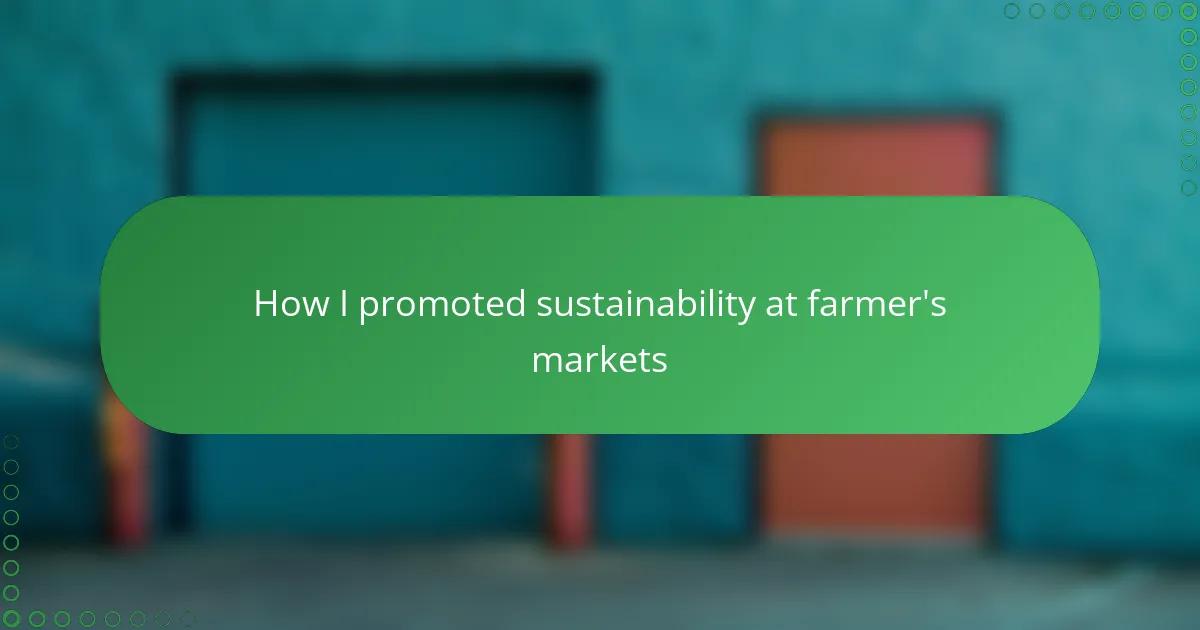Key takeaways
- Handmade paper crafts emphasize sustainability by using recycled materials, fostering environmental respect and creativity.
- Engaging customers through storytelling and hands-on experiences deepens their connection to sustainable crafting, inspiring mindful making.
- Promoting sustainability at farmers markets involves educating others about eco-friendly practices and encouraging community participation.
- Measuring sustainability efforts can include tracking behavior changes, conversations about materials, and attendance at workshops, highlighting the impact of personal engagement.
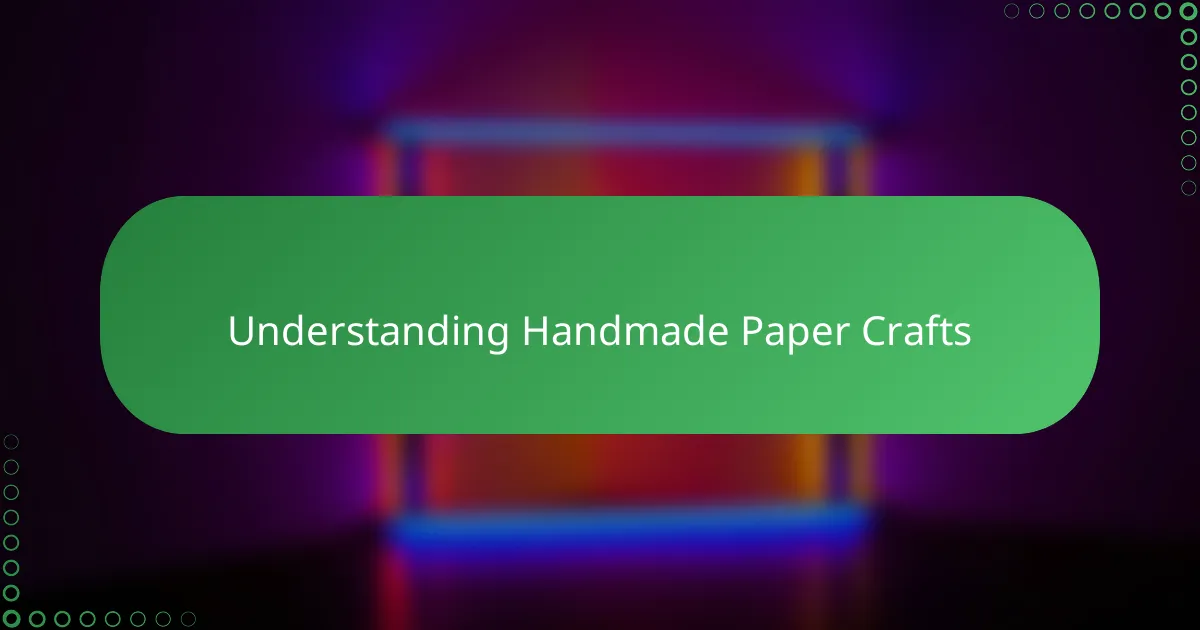
Understanding handmade paper crafts
Handmade paper crafts captivate me because each sheet carries a story—fibers intertwined by hand, not machine. Have you ever noticed how the texture of handmade paper feels alive, almost as if it holds the essence of nature itself? This tactile connection makes crafting more meaningful.
When I first tried making paper by hand, I was amazed by the patience and care needed to transform raw materials into something so delicate yet durable. It’s a process that demands appreciation for sustainability, craftsmanship, and creativity all at once. Don’t you think this slow, thoughtful approach stands in stark contrast to mass-produced paper?
What truly fascinates me is how handmade paper embraces imperfections, turning what some might see as flaws into unique art marks. It reminds me that beauty often lies in authenticity rather than uniformity—something we can all reflect on, especially in our fast-paced world.
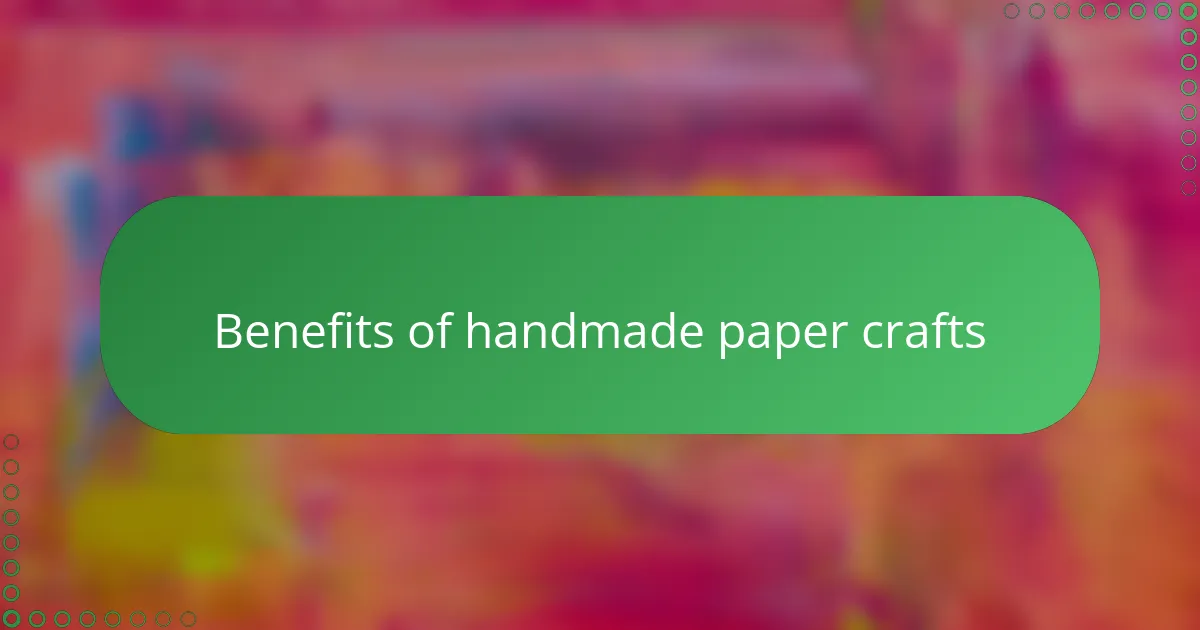
Benefits of handmade paper crafts
One of the biggest benefits I’ve found in handmade paper crafts is how sustainably they honor the materials. Instead of wasting resources, handmade paper often uses recycled fibers or natural plant remnants, giving new life to what might have been tossed aside. Isn’t it wonderful knowing that your craft project supports environmental care without sacrificing beauty?
Also, I love how handmade paper crafts encourage mindfulness and patience. When I create with these papers, I feel a calm focus that’s rare in today’s fast world. Have you ever noticed how working with something crafted by hand slows you down, making each moment and detail more meaningful?
Beyond environmental and emotional rewards, handmade paper has a unique aesthetic that mass-produced paper simply can’t match. The textures, the small irregularities—these details make each piece distinct and full of personality. It makes me wonder: why settle for ordinary when every craft can be a personal masterpiece?
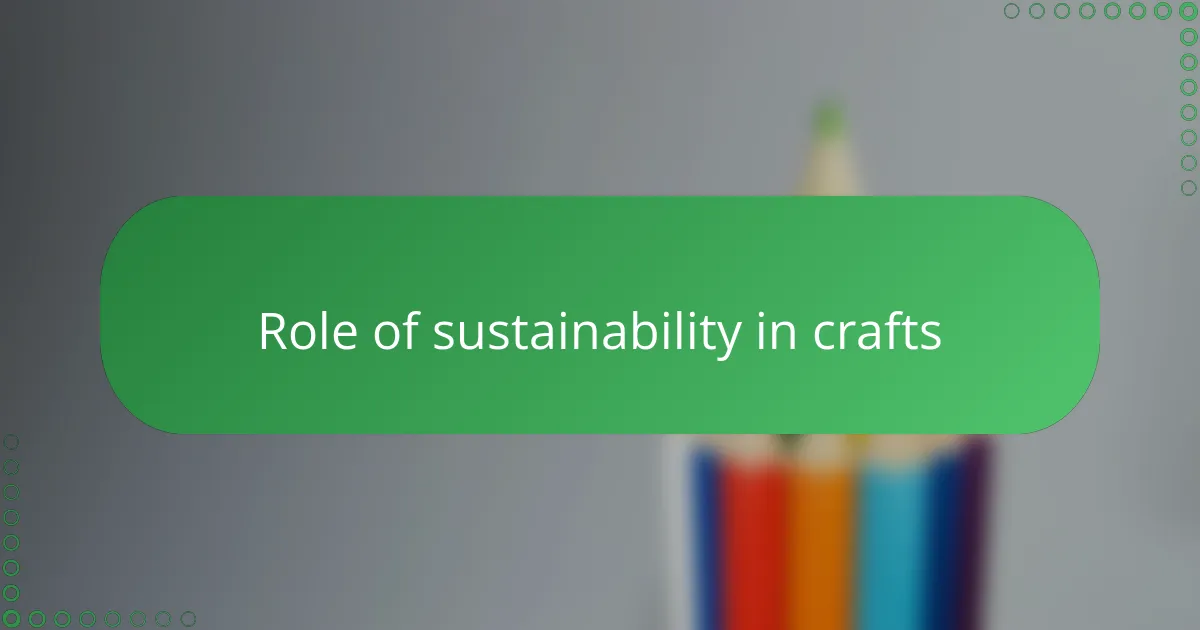
Role of sustainability in crafts
Sustainability in crafts isn’t just a trend to me; it’s a fundamental value that shapes every choice I make. When I think about my handmade paper projects, I realize how using eco-friendly materials turns crafting into a form of environmental respect. Have you ever paused to consider how each recycled fiber you include can reduce waste and nurture the planet?
Crafting sustainably feels deeply rewarding because it connects creativity with responsibility. I’ve noticed that when I source natural fibers or repurpose scraps, my work gains a richer story—one that honors nature’s cycles rather than ignoring them. Doesn’t it feel good to create something beautiful that also leaves a lighter footprint on our world?
In my experience, sustainability elevates crafts from mere hobbies to mindful practices. It invites me to reflect on consumption and encourages innovation within limits. When was the last time a craft made you rethink how your everyday choices impact the earth? For me, sustainability in crafts is that gentle nudge toward living—and creating—with greater intention.
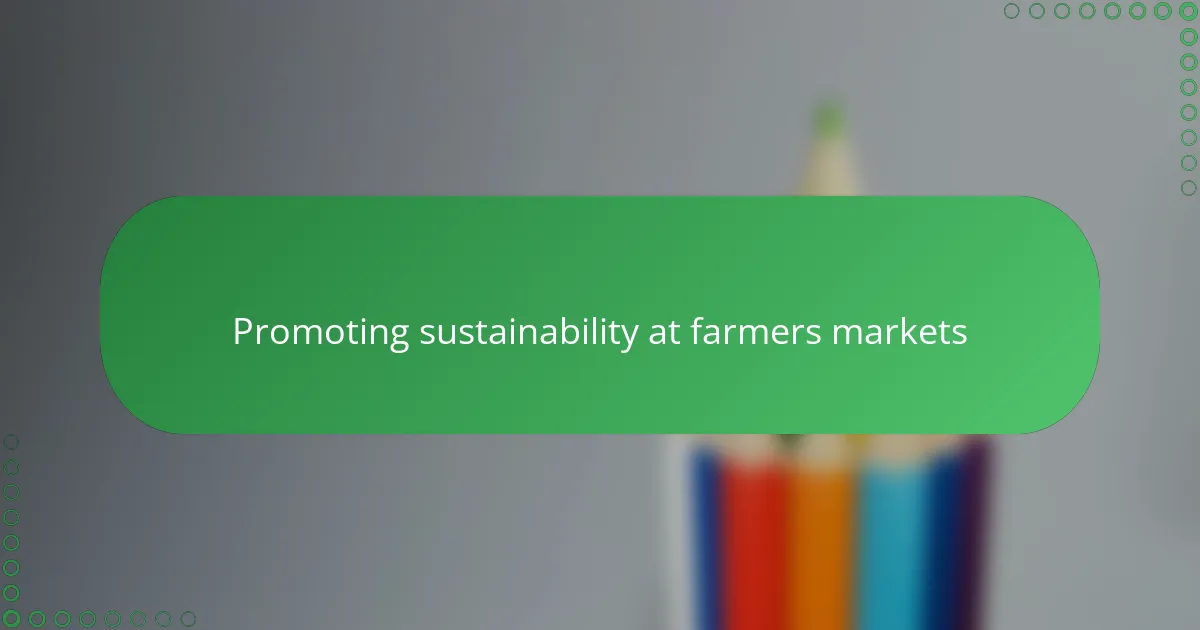
Promoting sustainability at farmers markets
At farmers markets, I found small but meaningful ways to promote sustainability that felt both effective and personal. For example, I always bring reusable bags and encourage vendors to use compostable packaging, which sparked conversations about reducing plastic waste. Have you ever noticed how a simple habit change, like swapping plastic for natural fibers, can inspire others to think differently?
One memorable moment was setting up a small display of handmade paper products made from recycled materials right next to fresh produce. It was satisfying to see people pause, touch the unique textures, and ask questions about how the paper was made and why it mattered. Moments like that remind me how education and visibility can quietly shift mindsets toward more sustainable choices.
I also championed the idea of community sharing by organizing a workshop on making seed paper crafts that people could plant afterward. This hands-on experience connected crafting to nature’s cycles in a tangible way, deepening my belief that sustainability at farmers markets isn’t just about what we buy—it’s about how we nurture relationships with both the earth and each other. What better place to foster that than among growers, artisans, and conscious consumers?
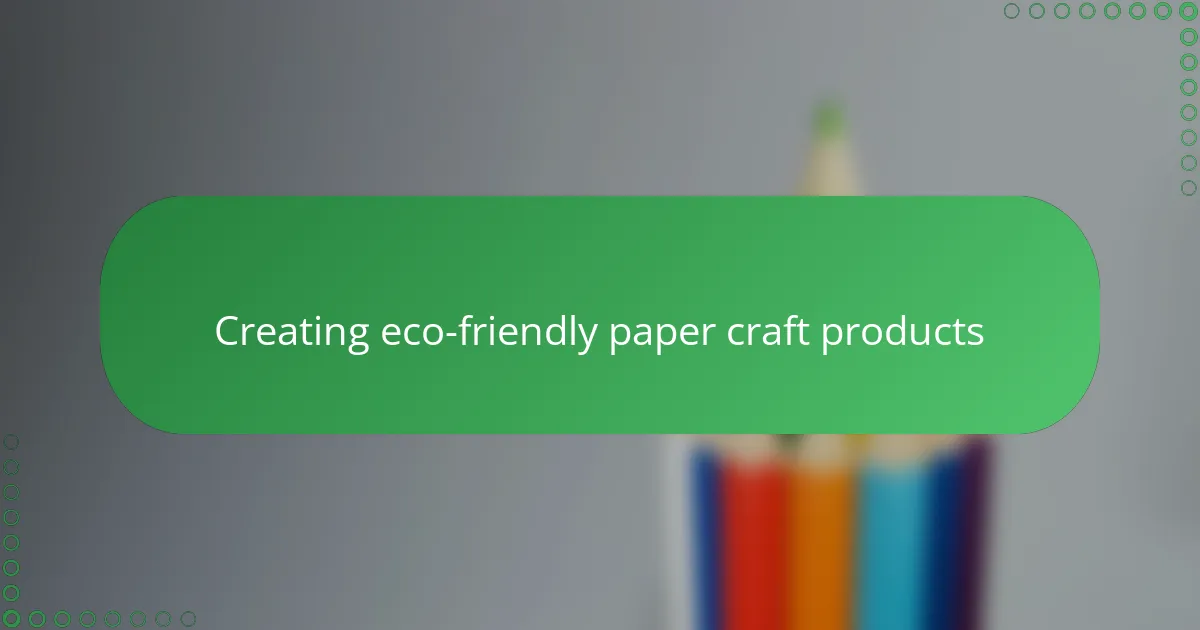
Creating eco-friendly paper craft products
When I create eco-friendly paper craft products, I always start by carefully choosing materials that are gentle to the environment, like recycled fibers or natural plant residues. It feels satisfying knowing each sheet I make not only looks beautiful but also reduces waste and honors nature’s resources. Have you ever considered how the simple choice of materials can transform a craft’s impact far beyond its appearance?
One technique I’ve grown fond of is embedding seeds into the paper, turning each piece into something that can grow after use. This small act feels like giving back to the earth—crafting becomes more than just art; it becomes a cycle of life. I find it deeply rewarding to watch someone plant a seed paper card and know that my work has contributed to new growth.
I also pay attention to every step, avoiding toxic dyes or harsh chemicals, which keeps my creations safe for both makers and buyers. It’s moments like these that remind me crafting sustainably requires thoughtfulness in every detail—don’t you think that caring mindset adds an extra layer of meaning to handmade paper?
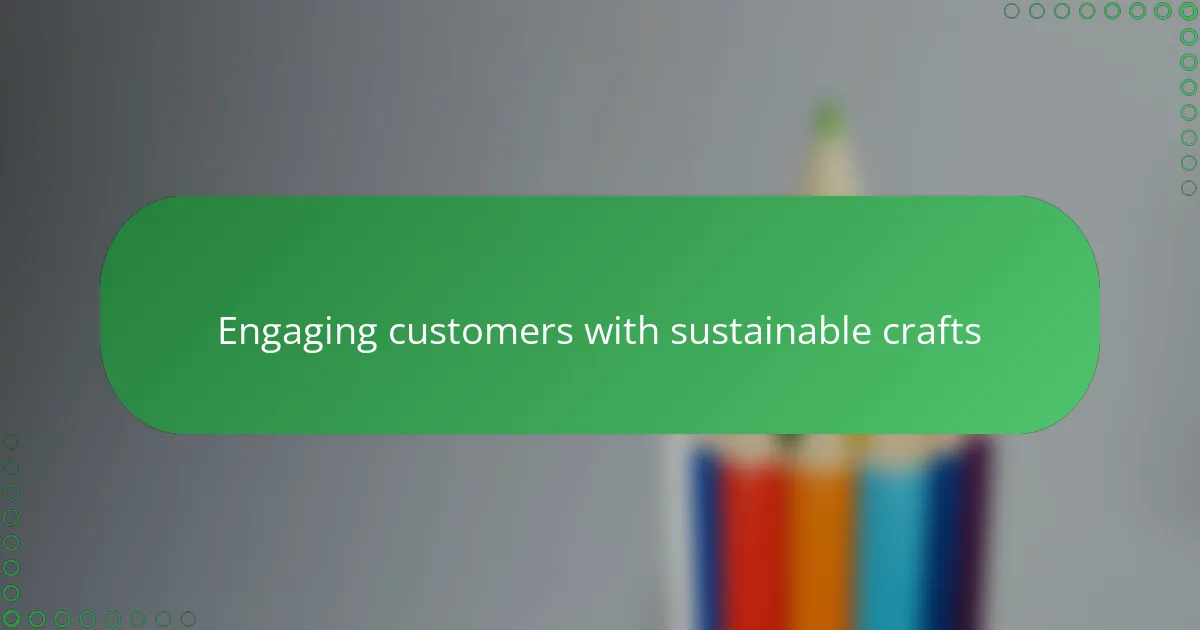
Engaging customers with sustainable crafts
Engaging customers with sustainable crafts often starts with inviting them to experience the story behind each piece. At my market stall, when I share how the fibers were recycled or how the paper can grow into plants, people don’t just see a product—they connect with a purpose. Have you noticed how storytelling transforms simple crafts into meaningful conversations?
I’ve found that hands-on experiences truly deepen this connection. Offering small samples or demonstrations lets customers feel the texture and freshness of handmade paper, sparking curiosity about sustainability. When someone touches a seed-embedded sheet and imagines planting it, the idea of eco-friendly crafting suddenly becomes real and personal.
What excites me most is seeing how these interactions inspire customers to think beyond buying and start creating themselves. They leave not just with a craft, but with a new appreciation for slow, thoughtful making. Isn’t that the kind of impact that makes promoting sustainability at farmers markets so rewarding?
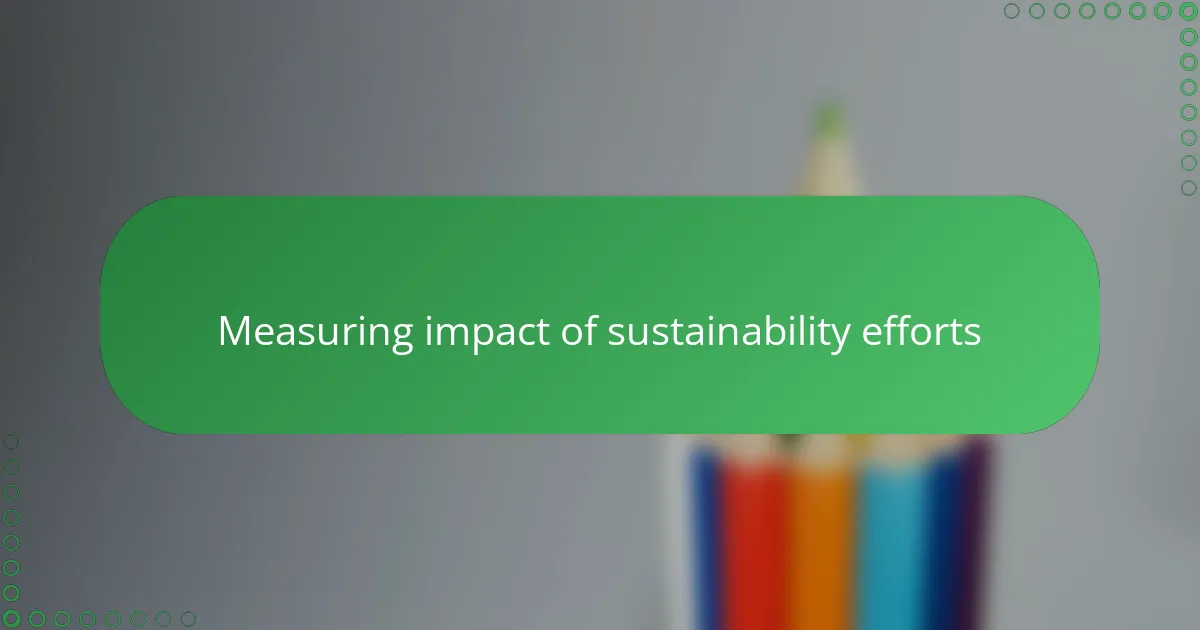
Measuring impact of sustainability efforts
Measuring the impact of sustainability efforts isn’t always straightforward, but I’ve found that keeping track of small changes—like how many vendors switched to compostable packaging after our chats—gives me a tangible sense of progress. Have you ever noticed how seeing real shifts in behavior makes your efforts feel more meaningful? For me, those little victories spark motivation to keep pushing.
I also like to reflect on the conversations sparked at the market. When customers ask about where the fibers come from or how seed papers work, it signals that awareness is growing, even if it’s just one person at a time. Don’t you think that changing minds is just as crucial as changing products? These moments are like quiet ripples that spread sustainability beyond the market stalls.
Tracking seed paper workshop attendance became another personal benchmark. The smiles when people realize they can plant their crafts fuel my belief that impact often starts with hands-on experiences. It’s rewarding to think that those moments might inspire a lifelong habit of eco-friendly creativity. How often do you find that an experience, rather than a product, leaves a deeper mark?
